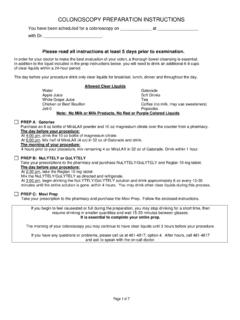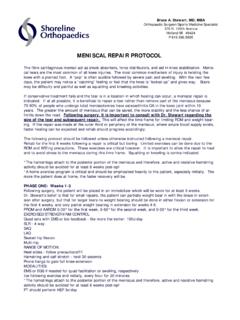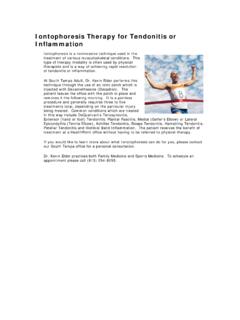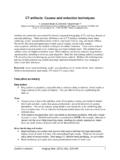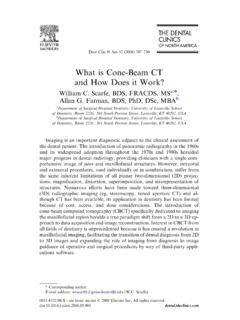Transcription of Patient Instructions for CT & CTA - Medfusion
1 Patient Instructions for CT & CTA What is a ct scan ? A ct scan obtains images of parts of the body that cannot be seen on a standard x-ray. Therefore, these scans often result in earlier diagnosis and more successful treatment of many diseases. Thousands of x-ray beams are passed quickly through the area being studied. The images are then reconstructed by a computer to give detailed views and information to the physician for diagnosis and treatment. What is a CT Angiogram (CTA) scan ? CTA is an examination that uses x-rays to look at the body s anatomy and arteries and to visualize the blood flow in the arteries throughout the body. Contrast dye is injected through an IV into a vein in the arm.
2 Thousands of X-Ray beams are passed quickly through the area being studied. The images are then reconstructed by a computer to give detailed views and information to the physician for diagnosis and treatment. *Most scans are done with contrast dye. Blood work: Most patients will be receiving contrast medium (X-ray dye) and need to have certain blood work completed within 30 days before the exam. The blood tests that are needed include a Creatinine level and BUN. You will receive a lab slip from the physician who ordered this procedure. Have the results faxed to the MCVI office at (989) 754-3019. This blood work is very important as it tells the physician the current status of your kidney function to insure it is proper to perform the CTA.
3 What Happens During the Test? When you arrive at MCVI, you will be questioned about your medical history, and an IV will be placed in your arm. You will lie on a table which will move you in and out of the scanner. You may be asked to hold your breath at times. If receiving contrast medium (X-Ray dye) it will be injected at some time during the procedure which usually makes patients feel very warm for a few seconds. The scanner is not enclosed, so you will never feel like you are in a closed space. The entire scan only takes a few minutes but you should allow approximately 45 minutes for the check-in, preparation time, scan , and observation period. The results of the scan will be sent to your physician.
4 Over Revised 5/6/2008 Date:_____ Account #:_____ Patient Name:_____ DOB_____ Please follow these Instructions carefully (unless otherwise directed) On the Night Before the Test: *Drink plenty of water *Do not drink any caffeine containing beverages for 12 hours prior to your test *Do not take any antihistamines for 12 hours prior to your test On the Day of the Test: *Drink plenty of water but none within one hour of the test *Do not eat any food for 4 hours prior to the test *Do not drink any caffeine containing beverages for 12 hours prior to your test *Do not take any antihistamines for 12 hours prior to your test *You may take your regular medications prior to the test *Wear loose comfortable clothing (no metal or zippers); most patients do not need to undress After the Test: *Drink plenty of water, at least 4 full glasses of water in the next few hours *After receiving IV contrast, some people may experience a mild flushed feeling.
5 If you do, rest and relax, and drink more fluids for 24 hours. *On occasion, a Patient might experience a mild rash up to 24 hours after the test. This is not dangerous. If this occurs, you can take Benadryl 25mg and increase your fluid intake. *If you experience trouble breathing, this can be serious. If it is severe then call 911 IMMEDIATELY. If it is mild, call your primary care doctor or your cardiologist s office, or call MCVI at 989-754-3000. *If you take any of these medications: Glucophage/Metformin, Avandament, Glucavance or Metaglip, please do not take for 48 hours after completing test. For Cardiac CTA ONLY *Hold all erectile dysfunction medications at least 48 hours prior to test.
6 IF NOT ON A BETA *Take 50mg of lopressor (metoprolol) on the night before the test *Take 50mg of lopressor (metoprolol) one hour before the test *You may receive intravenous medication to lower your heart rate prior to the test.
